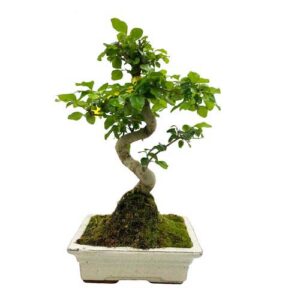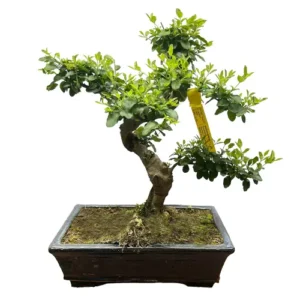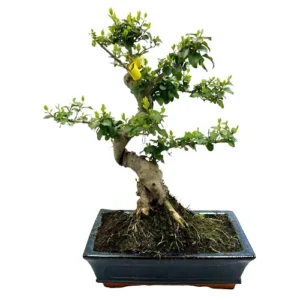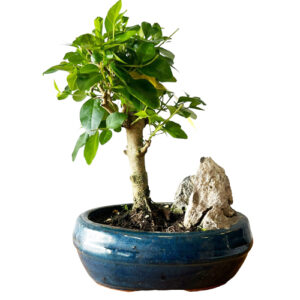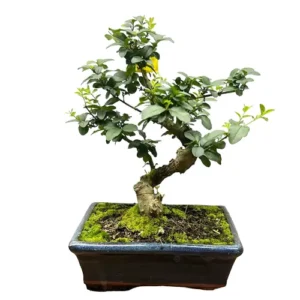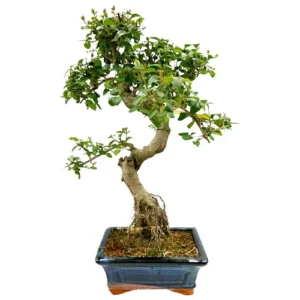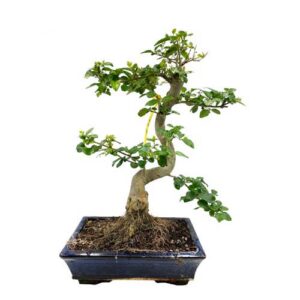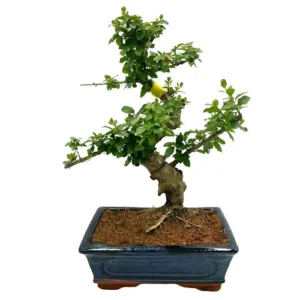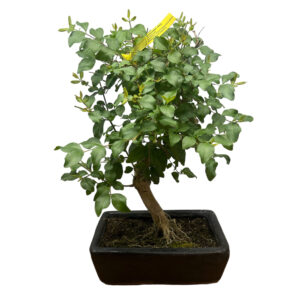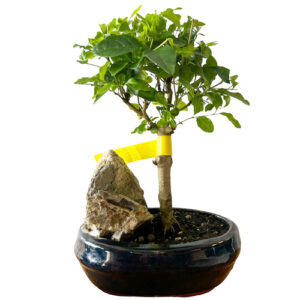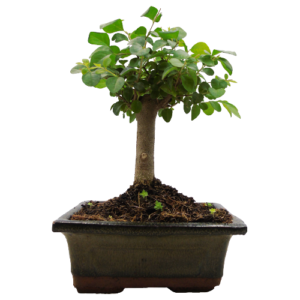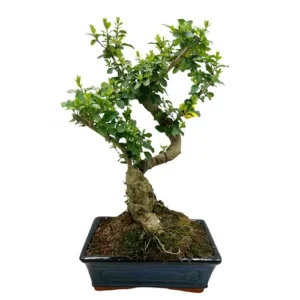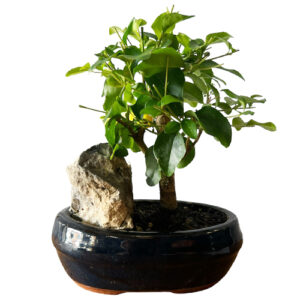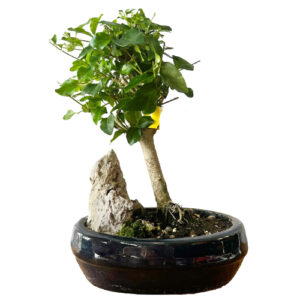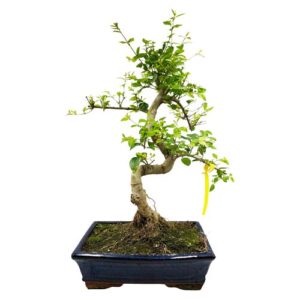Ligustrum Sinense
Mandarin Tree Bonsai
Ligustrum is a deciduous shrub native to China but can now be found in most continents often being used for hedging due to its fast-growing habit. Also known as Chinese privet, they are popular with beginners in bonsai because they are quite adaptable and respond well to being pruned.
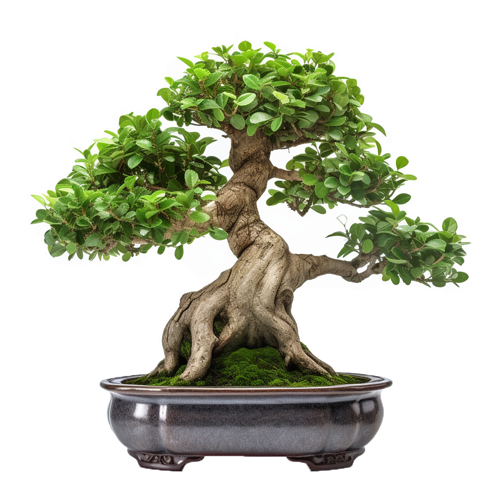
Mandarin Bonsai Care Tips
Like most semi-tropical bonsai trees, during the growing seasons of spring and summer, your mandarin tree’s growth and health would benefit from the extra sunlight and airflow that the summer months bring, so consider placing it outside in a sunlit spot once it gets warm and sunny. Note that the mandarin does not tolerate big drops in temperature well and ensure that it is protected from the wind and temperatures overnight do not drop under 10 °C.
As autumn comes around, bring your mandarin into the house and provide it with a warm and well-lit space, keeping constant temperature between 10 °C and 20 °C with high humidity. If it is difficult to keep your tree warm and with enough light over the winter, consider investing in heaters and artificial lighting and take into account that the warmer the position, the more light is needed.
There is no definitive guide to watering and it should be conducted on an observational schedule, not a routine. This means that it is important to keep an eye on the moisture levels of the soil to avoid over and under watering, both which can lead to dropping leaves and/or root death. The amount of water a bonsai requires depends on pot size, climate, airflow, soil and tree type so it is best to use your eyes and fingers to assess whether the soil is damp, wet or dry.
If the top inch or so of soil has dried, it is ready to be watered. When you water, try to get an even coverage over the roots and soil, allowing water to flow out from the bottom of the pot to ensure a good soaking.
If you are a first-time bonsai owner, another way to water is by submerging the entire pot in water until the bubbles stop. If you choose this method, be aware that your bonsai may not need watering for another two to four days, but this will depend on the factors mentioned above such as soil type, pot size and climate.
A mandarin tree also requires high humidity, and this can be achieved by placing a gravel tray under the pot, as well as using a mister to spray the leaves.
Using fertiliser on your Ligustrum will help encourage healthy growth and this should be done periodically from once a week to every two months and only during the growing season. You can start adding Chrysal Liquid Bonsai Feed to your water from March until October and use weekly. Use Naruko Fertiliser Slow Release Bonsai Feed once every one to two months. With Buddhist Pine trees, less is more, and we tend to advise using half the recommended dosage to see how your Buddhist Pine reacts first.
Pruning your bonsai is important not only to maintain or create an aesthetic style but to also ensure light and airflow can reach inner leaves and the mandarin bonsai tolerates pruning very well. To trim and maintain the appearance of the tree, allow the shoots to grow up to 4cm and then cut back with sharp bonsai scissors to two leaves left. This should be done during the spring and summer growing season and will encourage back budding and new leaf growth. Harder pruning of the branches and stems should be left until the winter or early spring before new growth starts.
Training your bonsai using wiring is possible to create a lovely tree silhouette, and can be done any time of the year, but spring and summer are usually best when the branches are more supple and pliable. We recommend using wires with a thickness that matches the thickness of the branch: if the wire you choose is too thick you will damage the bark. If it is too thin, it won’t be effective.
Repotting your tree is an important way to provide a fresh and suitable soil mix and ensure appropriate root health. Repot in early spring. Generally, your mandarin will need to be re-potted once every two years if it is young, while older ones can stay in their pots for longer. However, you should always check if it has become root-bound before you change pots. You can do this by lifting the tree gently out of the pot by the main trunk and examining the root system. You will know it is ready if you can see that the roots are circling around each other and the pot. If, however, they still appear contained in the soil, you should place it back and wait until the following spring to check again.
Trees that are ready for repotting will require root pruning, a suitable new pot and appropriate soil mix.
When repotting, do not cut back the root mass by a large amount, and choose a well-draining soil mix that has a neutral or slightly higher PH value of 5-6 but not over 7. We tend to use a mixture of different speciality bonsai soils on our trees. Every species is different so please contact us for free soil-mix advice or to take advantage of our repotting service.
Bonsai make for a one-of-a-kind indoor plant offering elegance, nature and art all in one minute form. Across an array of exquisite and erudite species, they all demand their own specific care and cultivation needs in order for their beauty to flourish. We have an extensive library of care guides for indoor bonsai trees so you can make an informed and considered choice. It’s not about selecting the perfect bonsai, it’s about selecting the perfect bonsai for you.
Mandarin Bonsai - Typical Queries
How to propagate my Mandarin Tree bonsai?
You can propagate your Mandarin Tree bonsai by seeds, cuttings, or grafting. Seeds are easy to obtain from the fruits, but they may not produce true to the parent plant. Cuttings are faster and more reliable, but they require a humid environment and a rooting hormone. Grafting is the most advanced and difficult method, but it allows you to combine different varieties of citrus trees.
How to deal with pests and diseases on my Mandarin Tree bonsai?
You should inspect your Mandarin Tree bonsai regularly for any signs of pests and diseases, such as aphids, scale insects, spider mites, mealybugs, whiteflies, leaf spots, fungal infections, or citrus canker. You should use a soft brush, a cotton swab, or a spray of water to remove the pests, and apply a mild insecticide or fungicide if necessary. You should also isolate the affected tree from other plants and improve the growing conditions.
How to style my Mandarin Tree bonsai?
You can style your Mandarin Tree bonsai according to your preference and creativity, but you should also consider the natural characteristics and features of the tree. You can choose from various bonsai styles, such as formal upright, informal upright, slanting, cascade, semi-cascade, literati, forest, raft, or broom. You can also use wires, clamps, or weights to shape the branches and the trunk, but you should be careful not to damage the bark or the cambium.
How to display my Mandarin Tree bonsai?
You can display your Mandarin Tree bonsai on a stand, a table, a shelf, or a windowsill, depending on the size and the style of the tree. You should choose a location that provides enough light, air, and space for the tree, and that complements the overall aesthetic of the bonsai. You can also add some accessories, such as a pot, a tray, a mat, a figurine, or a stone, to enhance the beauty and harmony of the bonsai.

